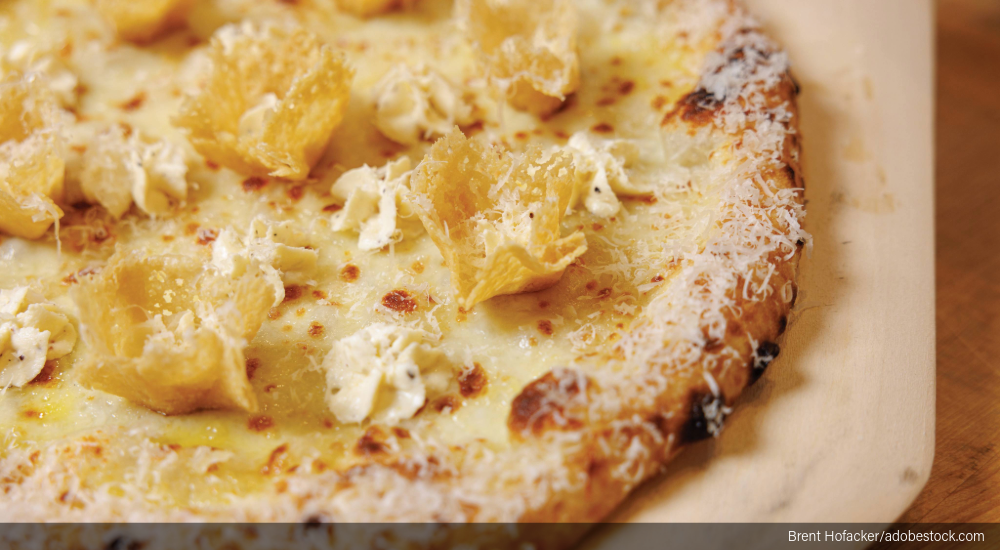What to know about using beer cheddar, gorgonzola, plant-based and other cheeses
Randy Lewis was making grilled cheese for his kids when a bit of cheddar seeped out and started getting crispy in the pan. Inspired by how the cheese bubbled when exposed to heat, the classically trained chef and owner of Hearth Wood Fired Pizza & Catering in Oakland, California, grabbed some piping tips and set to work creating tuilles – thin, crispy wafers typically used in French pastries – only in this case the tuilles were made of cheese, not pastry dough.
The eye-catching creation, which bears a resemblance to the lacy frico common on Detroit pizzas, adorned Lewis’ entry in the 2025 California Pizza Contest (pictured on this page). The white pie Hops & Dreams features tuilles formed from craft beer cheddar cheese, as well as an Italian-style raw cow’s milk cheese aged for 12 months and basket ricotta flavored with Vietnamese peppercorns and piped onto the pie post-bake.
“All the cheddars that I had in mind are pretty similar in the way they would work in the pan,” Lewis says, adding that the bitter notes inherent in a beer cheddar added the complex flavor he wanted for his entry in the contest’s The Big Cheese category, which requires participants to use California mozzarella and at least two other cheeses from the state.
Hops & Dreams
Lewis says he practiced making tuilles for a week to lock in the best weight, eventually landing on 0.25 ounces per lacy cup. He makes them by adding three or four separate portions of cheese to a nonstick skillet. After about two minutes – when the fat has rendered and the cheese is golden brown but still pliable – he places a piping tip in the center of each portion and folds the cheese around its steel walls, creating flower-like shapes with a flat bottom.
The tuilles harden quickly and can be set aside for use within a few days. Lewis warns against storing them in the refrigerator, since the moisture in that environment can ruin their crispy texture.
Flavored Ricotta
To create the Vietnamese pepper-flavored ricotta, Lewis grinds up peppercorns he purchased in Vietnam. Compared to black peppercorns, Vietnamese peppercorns are more floral and citrusy, he says, meaning they impart the flavor of a pizza topping without breaking any contest rules about simplicity in cheese pizzas.
“That’s the only peppercorn I really use. They’re just more flavorful,” he says. “Without being spicy, it still has a kick.”
After placing six craft beer cheddar tuilles around the 12-inch round pizza post-bake (each slice should have at least one tuille), Lewis uses a piping bag to add dollops of the flavored ricotta. He places a 1-teaspoon dollop inside each tuille and scatters others around the white pie.
Finally, he brushes the crust with his garlic oil (created by heating two ounces of extra virgin olive oil with two crushed garlic cloves for five minutes) and sprinkles the oil with a finely grated aged cow’s milk cheese.
Medley of Plant-based Cheeses
As a pizza maker who has been vegan for 27 years, Mark Mebus has probably tried every plant-based cheese on the market. The owner-operator of 20th Street Pizza in Philadelphia once bought an entire pallet of dairy-free cheese because distributors in the area didn’t yet carry the product he wanted.
“I had to warehouse it in the suburbs of Philadelphia and would drive up there and pick up 50 cases,” he recalls. “It was something new that I thought was a lot better at the time, and I just didn’t have that many options.”
Today, Mebus says, dairy-free cheese is not just easier to come by but also superior in quality. Commercial-grade vegan cheeses are made using cashews, coconuts, peas, potato, soy, tapioca and other bases.
“You’ve got to keep on top of what’s going on. It’s a constantly developing and emerging space,” Mebus tells Pizza Today. “Generally, it’s a product of fermentation like anything else.”
For his fourth pizzeria, Mebus has narrowed his focus to three main vegan cheeses: dry-aged, dairy-free shredded mozzarella, vegan Parmesan and ricotta he makes in-house from two different cashew cheese products.
Plant-based Mozzarella
When it comes to shredded vegan mozzarella, Mebus says his No. 1 criteria is melting ability. “Once the pizza is done baking, I don’t want to still see shreds of cheese,” he says, adding that meltability of vegan cheese has improved greatly in the past 10 years.
In an attempt to make vegan cheese taste more like … well, cheese, some companies overdo it on the cheese flavoring, leading to a taste Mebus calls “overpowering.” Instead, he looks for plant-based mozzarella with a mild flavor that allows other pizza ingredients to shine.
Even vegans are not immune to the draw of a good cheese pull, and Mebus prizes a mozzarella that has a bit of stretch but is not sticky. Finally, he says, the perfect animal-free mozzarella browns when heated.
Vegan Parmesan
In addition to mozzarella, most pies at 20th Street Pizza also use vegan Parmesan, which adds the rich, salty flavor pizza lovers of all diets enjoy.
“I like the variation in texture when they’re both on there,” Mebus says. While some dairy-free Parm comes pre-shredded, 20th Street Pizza buys it in blocks and shreds them fresh onsite.
The versatile product also takes the pizzeria’s vegan baked meatballs and garlic knots to the next level, meaning everyone can enjoy them.
Cashew Ricotta
One of Mebus’s favorite local producers is a cashew cheese company that makes products with clean, simple ingredients. To create the pizzeria’s vegan lemon ricotta – also offered as an appetizer served with three garlic knots and topped with extra virgin olive oil, pistachio and basil – Mebus whips two cashew cheeses together to create a melty spread used on the restaurant’s white pie along with the mozzarella and Parmesan.
“The one drawback to the cashew cheese is that it’s a little wetter, so it can weigh down the dough a little bit. … If I was to totally slather it on pizza, I think it would weigh that down too much,” he says. “That’s why we just whip it up and use it like you would use a ricotta.”
More than 10 years ago, operators offering vegan pizza would have to spray cheese with oil to prevent it from drying out during baking, but now plant-based cheeses can be used interchangeably with dairy cheese.
That said, Mebus believes there are big developments on the horizon when it comes to plant-based cheese, with companies working on products that incorporate casein protein, which gives milk-based cheese its flavor and texture. “I do get the impression that we’re right on the brink of vegan cheese taking another big turn.”
Blue Cheese, Gorgonzola and Cheddar, Oh My!
When he’s not entering pizza competitions, it’s common to find Lewis of California-based Hearth Wood Fired Pizza catering for clients. In that setting, he offers an expanded menu for clients to choose from, and the options include more high-end cheeses.
One such pie is the Fig and Prosciutto Pizza, finished with Gorgonzola and balsamic drizzle. Lewis says he uses both blue and gorgonzola cheeses sparingly because of their strong flavors. The cheeses have “such a high fat content that it doesn’t really burn, and it melts super quick all over the pizza.”
Prior to baking any pizza with fresh mozzarella, Lewis drains the cheese by slicing it into cubes and refrigerating them on a perforated pan overnight to let extra moisture escape. “If you don’t, and you put it on your pizza fresh out of the water, you’re going to have a soupy mess,” he says.
Finally, Lewis finishes all his pizzas with Pecorino Romano, which he credits with offering more sharpness and gamey flavor than Parmesan. “It’s a sheep’s milk cheese rather than cow’s milk, so it’s going to have a different flavor profile.”
KATE LAVIN is Senior Editor at Pizza Today.
 Read the November 2025 Issue of Pizza Today Magazine
Read the November 2025 Issue of Pizza Today Magazine
This month, we are diving deep on all things cheese. Learn how the fluctuating commodities market can impact the price you pay for mozzarella and other block cheeses. Then, find out how operators are using craft beer cheddar, gorgonzola and plant-based cheeses made from cashews, coconuts, peas and other bases to create pizzas that are visually and gastronomically stunning. Round out your education for the month by brushing up on pizzeria art, SOPs and winter squash.
Check out the full Digital Edition – Pizza Today November 2025.



